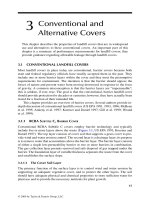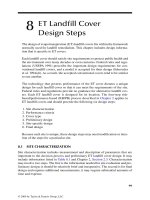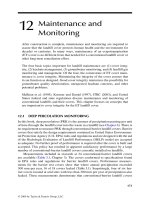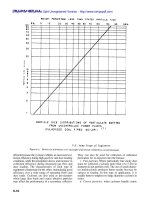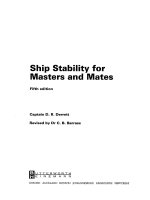Ship Stability for Masters and Mates 5 Episode 3 potx
Bạn đang xem bản rút gọn của tài liệu. Xem và tải ngay bản đầy đủ của tài liệu tại đây (498.28 KB, 35 trang )
TPC and displacement curves 59
Exercise 8
TPC curves
1 (a) Construct a TPC curve from the following data:
Mean draft (m) 1 2 3 4 5
TPC (tonnes) 3.10 4.32 5.05 5.50 5.73
(b) From this curve ®nd the TPC at drafts of 1.5 m and 2.1 m.
(c) If this ship ¯oats at 2.2 m mean draft and then discharges 45 tonnes of
ballast, ®nd the new mean draft.
2 (a) From the following information construct a TPC curve:
Mean draft (m) 12345
Area of water-plane (sq m) 336 567 680 743 777
(b) From this curve ®nd the TPC's at mean drafts of 2.5 m and 4.5 m.
(c) If, while ¯oating at a draft of 3.8 m, the ship discharges 380 tonnes of
cargo and loads 375 tonnes of bunkers, 5 tonnes of stores, and 125
tonnes of fresh water, ®nd the new mean draft.
3 From the following information construct a TPC curve:
Mean draft (m) 1 3 5 7
TPC (tonnes) 4.7 10.7 13.6 15.5
Then ®nd the new mean draft if 42 tonnes of cargo is loaded whilst the ship
is ¯oating at 4.5 m mean draft.
Displacement curves
4 (a) From the following information construct a displacement curve:
Displacement (tonnes) 376 736 1352 2050 3140 4450
Mean draft (m) 1 23456
(b) From this curve ®nd the displacement at a draft of 2.3 m.
(c) If this ship ¯oats at 2.3 m mean draft and then loads 850 tonnes of
cargo and discharges 200 tonnes of cargo, ®nd the new mean draft.
(d) Find the approximate TPC at 2.5 m mean draft.
5 The following information is taken from a ship's displacement scale :
Displacement (tonnes) 335 1022 1949 2929 3852 4841
Mean draft (m) 1 1.5 2 2.5 3 3.5
(a) Construct the displacement curve for this ship and from it ®nd the draft
when the displacement is 2650 tonnes.
(b) If this ship arrived in port with a mean draft of 3.5 m, discharge d her
cargo, loaded 200 tonnes of bunkers, and completed with a mean draft
of 2 m, ®nd how much cargo she discharged.
(c) Assuming that the ship's light draft is 1 m, ®nd the deadweight when
the ship is ¯oating in salt water at a mean draft of 1.75 m.
6 (a) From the following information construct a displacement curve:
Displacement (tonnes) 320 880 1420 2070 2800 3680
Draft (m) 1 1.5 2 2.5 3 3.5
(b) If this ship's light draft is 1.1 m, and the load draft 3.5 m, ®nd the
deadweight.
60 Ship Stability for Masters and Mates
(c) If the vessel had on board 300 tonnes of cargo, 200 tonnes of ballast,
and 60 tonnes of fresh water and stores, what would be the salt water
mean draft.
7 (a) Construct a displacement curve from the following data:
Draft (m) 1 23456
Displacement (tonnes) 335 767 1270 1800 2400 3100
(b) The ship commenced loading at 3 m mean draft and, when work ceased
for the day, the mean draft was 4.2 m. During the day 85 tonnes of salt
water ballast had been pumped out. Find how much cargo had been
loaded.
(c) If the ship's light draft was 2 m ®nd the mean draft after she had taken
in 870 tonnes of water ballast and 500 tonnes of bunkers.
(d) Find the TPC at 3 m mean draft.
8 (a) From the following information construct a displacement curve:
Draft (m) 1 23456
Displacement (tonnes) 300 1400 3200 5050 7000 9000
(b) If the ship is ¯oating at a mean draft of 3.2 m, and then loads 1800
tonnes of cargo and 200 tonnes of bunkers, and also pumps out 450
tonnes of water ballast, ®nd the new displacement and ®nal mean draft.
(c) At a certain draft the ship discharged 1700 tonnes of cargo and loaded
400 tonnes of bunkers. The mean draft was then found to be 4.5 m. Find
the original mean draft.
Chapter 9
Form coef®cients
The coef®cient of ®neness of the water-plane
area (C
w
)
The coef®cient of ®neness of the water-plane area is the ratio of the area of
the water-plane to the area of a rectangle having the same length and
maximum breadth.
In Figure 9.1 the area of the ship's water-pla ne is shown shaded and
ABCD is a rectangle having the same length and maximum breadth.
Coefficient of fineness C
w
Area of water-plane
Area of rectangle ABCD
Area of water-plane
L Â B
; Area of the water-plane L ÂB Â C
w
Example 1
Find the area of the water-plane of a ship 36 metres long, 6 metres beam, which
has a coef®cient of ®neness of 0.8.
Area of water-plane L Â B Â C
w
36 Â 6 Â 0X8
Ans.
Area of water-plane 172X8sqm
Fig. 9.1
Example 2
A ship 128 metres long has a maximum beam of 20 metres at the waterline, and
coef®cient of ®neness of 0.85. Calculate the TPC at this draft.
Area of water-plane L Â B Â C
w
128 Â 20 Â 0X85
2176 sq metres
TPC
SW
WPA
97X56
2176
97X56
Ans.
TPC
SW
22X3 tonnes
The block coef®cient of ®neness of
displacement (C
b
)
The block coef®cient of a ship at any particular draft is the ratio of the
volume of displacement at that draft to the volume of a rectangular block
having the same overall length, breadth, and depth.
In Figure 9.2 the shaded portion represents the volume of the ship's
displacement at the draft concerned, enclosed in a rectangular block having
the same overall length, breadth, and depth.
Block coefficient C
b
Volume of displacement
Volume of the block
Volume of displacement
L Â B Âdraft
; Volume of displacement L ÂB Â draft ÂC
b
62 Ship Stability for Masters and Mates
Fig. 9.2
Ship's lifeboats
The cubic capacity of a lifeboat should be determined by Simpson's rules or
by any other method giving the same degree of accuracy. The accepted C
b
for a ship's lifeboat constructed of wooden planks is 0.6 and this is the
®gure to be used in calculations unless another speci®c value is given. Thus,
the cubic capacity of a wooden lifeboat can be found using the formula:
Volume L  B ÂDepth  0X6 cubic metres.
The number of persons wh ich a lifeboat may be certi®ed to carry is equal
to the greatest whole number obtained by th e formula V/x where `V' is the
cubic capacity of the lifeboat in cubic metres and `x' is the volume in cubic
metres for each person. `x' is 0.283 for a lifeboat 7.3 metres in length or
over, and 0.396 for a lifeboat 4.9 metres in length. For intermediate lengths
of lifeboats, the value of `x' is determined by interpolation.
Example 1
Find the number of persons which a wooden lifeboat 10 metres long, 2.7 metres
wide, and 1 metre deep may be certi®ed to carry.
Volume of the boat L ÂB Â D Â 0X6cuX m
10 Â 2X7 Â1 Â 0X6
16X2cuX m
Number of persons V/x
16X2a0X283
Ans.
Number of persons 57
Example 2
A ship 64 metres long, 10 metres maximum beam, has a light draft of 1.5
metres and a load draft of 4 metres. The block coef®cient of ®neness is 0.6 at
the light draft and 0.75 at the load draft. Find the deadweight.
Light displacement L  B  draft  C
b
cu. m
64 Â 10 Â 1X5 Â0 X6
576 cu. m
Load displacement L  B  draft  C
b
cu. m
64 Â 10 Â 4 Â0X75
1920 cu. m
Deadweight Load displacement N Light displacement
1920N576cu. m
Deadweight 1344 cu. m
1344 Â 1X025 tonnes
Ans.
Deadweight 1377X6 tonnes
Form coef®cients 63
The midships coef®cient (C
m
)
The midships coef®cient to any draft is the ratio of the transverse area of
the midships Section (A
m
) to a rectangle having the same breadth and
depths.
In Figure 9.3 the shaded portion represents the area of the midships
section to the waterline WL, enclosed in a rectangle having the same
breadth and depth.
Midships coefficient C
m
Midships area A
m
Area of rectangle
Midships area A
m
B Â d
or
Midships area A
m
B Â d ÂC
m
The prismatic coef®cient (C
p
)
The prismatic coef®cient of a ship at any draft is the ratio of the volume of
displacement at that draft to the volume of a prism having the same length
as the ship and the same cross-sectional area as the ship's midships area.
The prismatic coef®cient is used mostly by ship-model researchers.
In Figure 9.4 the shaded portion represents the volume of the ship's
displacement at the draft concerned, enclosed in a prism having the same
length as the ship and a cross-sectional area equal to the ship's midships
area (A
m
).
Prismatic coefficient C
p
Volume of ship
Volume of prism
Volume of ship
L Â A
m
64 Ship Stability for Masters and Mates
Fig. 9.3
or
Volume of ship L ÂA
m
 C
p
Note
C
m
 C
p
A
m
B Â d
Â
Volume of ship
L Â A
m
Volume of ship
L Â B Âd
C
b
; C
m
 C
p
C
b
or
C
p
C
B
C
m
Note.C
p
is always slightly higher than C
B
at each waterline.
Having described exactly what C
w
,C
b
,C
w
and C
p
are, it would be useful
to know what their values would be for several ship types.
First of all it must be remembered that all of these form coef®cients will
never be more than unity.
For the C
b
values at fully loaded drafts the following table gives good
typical values:
Form coef®cients 65
Fig. 9.4
Ship type Typical C
b
Ship type Typical C
b
fully loaded fully loaded
ULCC 0.850 General cargo ship 0.700
Supertanker 0.825 Passenger liner 0.625
Oil tanker 0.800 Container ship 0.575
Bulk carrier 0.750 Coastal tug 0.500
medium form ships (C
b
approx. 0.700), full-form ships (C
b
b 0X700), ®ne-form ships (C
b
` 0X700).
To extimate a value for C
w
for these ship types at their fully loaded drafts,
it is useful to use the following rule-of-thumb approximation.
C
w
2
3
 C
b
1
3
@ Draft Mld only!
Hence, for the oil tanker, C
w
would be 0.867, for the general cargo ship
C
w
would be 0.800 and for the tug C
w
would be 0.667 in fully loaded
conditions.
For merchant ships, the midships co ef®cient or midship area coef®cient is
0.980 to 0.990 at fully loaded draft. It depends on the rise-of-¯oor and the
bilge radius. Rise of ¯oor is almost obsolete nowadays.
As shown before;
C
p
C
b
C
m
Hence for the bulk carrier, when C
b
is 0.750 with a C
m
of 0.985, the C
p
will be:
C
p
0X750
0X985
0X761
@ Draft Mld
C
p
is used mainly by researchers at ship-model tanks carrying out tests to
obtain the least resistance for particular hull forms of prototypes.
C
b
and C
w
change as the drafts move from fully loaded to light-ballast to
lightship conditions. The diagram (Figure 9.5) shows the curves at drafts
below the fully loaded draft for a general cargo ship of 135.5 m LBP.
`K' is calculated for the fully loaded condition and is held constant for all
remaining drafts down to the ship's lightship (empty ship) waterline.
66 Ship Stability for Masters and Mates
Fig. 9.5. Variation of C
b
and C
w
values with draft. (Note how the two curves are
parallel at a distance of 0.100 apart).
Form coef®cients 67
Exercise 9
1 (a) De®ne `coef®cient of ®nenes s of the water-plane'.
(b) The length of a ship at the waterline is 100 m, the maximum beam is
15 m, and the coef®cient of ®neness of the water-plane is 0.8. Find the
TPC at this draft.
2 (a) De®ne `block coef®cient of ®neness of displacement'.
(b) A ship's length at the waterline is 120 m when ¯oating on an even keel
at a draft of 4.5 m. The maximum beam is 20 m. If the ship's block
coef®cient is 0.75, ®nd the displacement in tonnes at this draft in salt
water.
3 A ship is 150 m long, has 20 m beam, load draft 8 m, light draft 3 m. The
block coef®cient at the load draft is 0.766, and at the light draft is 0.668.
Find the ship's deadweight.
4 A ship 120 m long Â15 m beam has a block coef®cient of 0.700 and is
¯oating at the load draft of 7 m in fresh water. Find how much more cargo
can be loaded if the ship is to ¯oat at the same draft in salt water.
5 A ship 100 m long, 15 m beam, and 12 m deep, is ¯oating on an even keel
at a draft ot 6 m, block coef®cient 0.8. The ship is ¯oating in salt water. Find
the cargo to discharge so that the ship will ¯oat at the same draft in fresh
water.
6 A ship's lifeboat is 10 m long, 3 m beam, and 1.5 m deep. Find the number
of persons which may be carried.
7 A ship's lifeboat measures 10 m Â2.5 m Â1 m. Find the number of persons
which may be carried.
Chapter 10
Simpson's Rules for
areas and centroids
Areas and volumes
Simpson's Rules may be used to ®nd the areas and volumes of irregular
®gures. The rules are based on the assumption that the boundaries of such
®gures are curves which follow a de®nite mathematical law. When applied
to ships they give a good approximation of areas and volumes. The
accuracy of the answers obtained will depend upon the spacing of the
ordinates and upon how near the curve follows the law.
Simpson's First Rule
This rule assumes that the curve is a parabola of the second order. A
parabola of the second order is one whose equation, referred to co-ordinate
axes, is of the form y a
0
a
1
x a
2
x
2
, where a
0
,a
1
, and a
2
are constants.
Let the curve in Figure 10.1 be a parabola of the second order. Let y
1
,y
2
and y
3
be three ordinates equally spaced at `h' units apart.
Fig. 10.1
The area of the elementary strip is ydx. Then the area enclosed by the
curve and the axes of reference is given by
Area of figure
2h
O
ydx
But y a
0
a
1
x a
2
x
2
; Area of figure
2h
O
a
0
a
1
x a
2
x
2
dx
a
0
x
a
1
x
2
2
a
2
x
3
3
!
2h
O
2a
0
h 2a
1
h
2
8
3
a
2
h
3
Assume that the area of figure Ay
1
By
2
Cy
3
Using the equation of the curve and substituting `x' for O, h and 2h
respectively:
Area of figure Aa
0
Ba
0
a
1
h a
2
h
2
Ca
0
2a
1
h 4a
2
h
2
a
0
A B Ca
1
hB 2C
a
2
h
2
B 4C
; 2a
0
h 2a
1
h
2
8
3
a
2
h
3
a
0
A B Ca
1
hB 2C
a
2
h
2
B 4C
Equating coef®cients:
A B C 2h, B 2C 2h, and B 4C
8
3
h
From which:
A
h
3
Y B
4h
3
Y and C
h
3
; Area of figure
h
3
y
1
4y
2
y
3
This is Simpson's First Rule.
It should be noted that Simpson's First Rule can also be used to ®nd the area
under a curve of the third order, i.e., a curve whose equation, referred to the
co-ordinate axes, is of the form y a
0
a
1
x a
2
x
2
a
3
x
3
, where a
0
,a
1
,
a
2
and a
3
are constants.
Simpson's Rules for areas and centroids 69
Summary:
A coef®cient of
1
3
with multipliers of 1, 4, 1 etc.
Simpson's Second Rule
This rule assumes that the equation of the curve is of the third order, i.e. of
a curve whose equation, referred to the co-ordinate axes, is of the form
y a
0
a
1
x a
2
x
2
a
3
x
3
, where a
0
,a
1
,a
2
and a
3
are constants.
In Figure 10.2:
Area of elementary strip ydx
Area of the figure
3h
O
ydx
3h
O
a
0
a
1
x a
2
x
2
a
3
x
3
dx
a
0
x
1
2
a
1
x
2
1
3
a
2
x
3
1
4
a
3
x
4
ÂÃ
3h
O
3a
0
h
9
2
a
1
h
2
9a
2
h
3
81
4
a
3
h
4
Let the area of the figure Ay
1
By
2
Cy
3
Dy
4
Aa
0
Ba
0
a
1
h a
2
h
2
a
3
h
3
Ca
0
2a
1
h 4a
2
h
2
8a
3
h
3
Da
0
3a
1
h 9a
2
h
2
27a
3
h
3
a
0
A B C Da
1
hB 2C 3D
a
2
h
2
B 4C 9Da
3
h
3
B 8C 27D
70 Ship Stability for Masters and Mates
Fig. 10.2
Equating coef®cients:
A B C D 3h
B 2C 3D
9
2
h
B 4C 9D 9h
B 8C 27D
81
4
h
From which:
A
3
8
h, B
9
8
h, C
9
8
h, and D
3
8
h
; Area of figure
3
8
hy
1
9
8
hy
2
9
8
hy
3
3
8
hy
4
or
Area of figure
3
8
hy
1
3y
2
3y
3
y
4
This is Simpson's Second Rule.
Summary:
A coef®cient of
3
8
with multipliers of 1, 3, 3, 1 etc.
Simpson's Third Rule
In Figure 10.3:
Area of the elementary strip ydx
Area between y
1
and y
2
in figure
h
O
ydx
a
0
h
1
2
a
1
h
2
1
3
a
2
h
3
Let the area between y
1
and y
2
Ay
1
By
2
Cy
3
Simpson's Rules for areas and centroids 71
Fig. 10.3
Then area Aa
0
Ba
0
a
1
h+a
2
h
2
Ca
0
2a
1
h 4a
2
h
2
a
0
A B Ca
1
hB 2C
a
2
h
2
B 4C
Equating coef®cients:
A B C h, B 2C ha2, B 4C ha3
From which:
A
5h
12
Y B
8h
12
Y and C À
h
12
; Area of figure between y
1
and y
2
5
12
hy
1
8
12
hy
2
À
1
12
hy
3
or
Area
h
12
5y
1
8y
2
À y
3
This is the Five/eight (or Five/eight minus one) rule, and is used to ®nd the area
between two consecutive ordinates when three consecutive ordinates are known.
Summary:
A coef®cient of
1
12
with multipliers of 5, 8, À1 etc.
Areas of water-planes and similar ®gures using
extensions of Simpson's Rules
Since a ship is uniformly built about the centre line it is only necessary to
calculate the area of half the water-plane and then double the area found to
obtain the area of the whole water-plane.
Figure 10.4 represents the starboard side of a ship's water-plane area. To
®nd the area, the centre line is divided into a number of equal lengths each
`h' m. long. The length `h' is called the common interval. The half-breadths, a,
b, c, d, etc., are then measured and each of these is called a half-ordinate.
Using Simpson's First Rule
This rule can be used to ®nd areas when there are an odd number of
ordinates.
Area of Figure 10.5(a)
h
3
a 4b c
72 Ship Stability for Masters and Mates
Fig. 10.4
If the common interval and the ordinates are measured in metres, the area
found will be in square metres.
Let this rule now be applied to a water-plane area such as that shown in
Figure 10.5(b).
The water-plane is divided into three separate areas and Simpso n's First
Rule is used to ®nd each separate area.
Area 1 ha3a 4b c
Area 2 ha3c 4d e
Area 3 ha3e 4f g
Area of
1
2
WP Area 1 Area 2 Area 3
; Area of
1
2
WP ha3a 4b cha3c 4d e
ha3e 4f g
or Area of
1
2
WP ha3a 4b 2c 4d 2e 4f g
This is the form in which the formula should be used. Within the brackets
the half-ordinates appear in their correct sequence from forward to aft. The
Simpson's Rules for areas and centroids 73
Fig. 10.5(a)
Fig. 10.5(b)
141 141
141
combined 1 4 2 4 2 4 1
multiplier
coef®cients of the half-ordinates are referred to as Simpson's Multipliers and
they are in the form: 1424241. Had there been nine half-ordinates, the
Multipliers would have been: 142424241. It is usually much easier to set
out that part of the problem within the brackets in tabular form. Note how
the Simpson's multipliers begin and end with 1, as shown in Figure 10.5(b).
Example
A ship 120 metres long at the waterline has equidistantly spaced half-ordinates
commencing from forward as follows:
0, 3.7, 5.9, 7.6, 7.5, 4.6, 0.1 metres respectively.
Find the area of the water-plane and the TPC at this draft.
Note. There is an odd number of ordinates in the water-plane and therefore the
First Rule can be used.
S
1
is used because it is a total; using Simpson's First Rule:
h
120
6
the common interval CI
; CI 20 metres
Area of WP
1
3
 CI  S
1
 2 for both sides
1
3
 20  90X5 Â2
Ans.
Area of WP 1207 sq m
TPC
SW
WPA
97X56
1207
97X56
Ans.
TPC 12 X37 tonnes
Note. If the half-ordinates are used in these calculations, then the area of half
the water-plane is found. If however the whole breadths are used, the total area
of the water-plane will be found. If half-ordinates are given and the WPA is
requested, simply multiply by 2 at the end of the formula as shown above.
74 Ship Stability for Masters and Mates
No.
1
2
ord. SM Area function
a0 10
b 3.7 4 14.8
c 5.9 2 11.8
d 7.6 4 30.4
e 7.5 2 15.0
f 4.6 4 18.4
g 0.1 1 0.1
90X5 S
1
Using the extension of Simpson's Second Rule
This rule can be used to ®nd the area when the number of ordinates is such
that if one be subtracted from the number of ordinates the remainder is
divisible by 3.
Area of Figure 10.6(a)
3
8
ha 3b 3c d
Now consider a water-plane area which has been divided up using seven
half-ordinates as shown in Figure 10.6(b).
The water-plane can be split into two sections as shown, each section
having four ordinates.
Area 1
3
8
ha 3b 3c d
Area 2
3
8
hd 3e 3f g
Area of
1
2
WP Area 1 Area 2
; Area of
1
2
WP
3
8
ha 3b 3c d
3
8
hd 3e 3f g
or
Area of
1
2
WP
3
8
ha 3b 3c 2d 3e 3f g
Simpson's Rules for areas and centroids 75
Fig. 10.6(a)
133 1
13 3 1
combined 1 3 3 2 3 3 1
multipliers
Fig. 10.6(b)
This is the form in which the formula should be used. As before, all of the
ordinates appear in their correct order within the brackets. The multipliers
are now 1332331. Had there been ten ordinates the multipliers would have
been 1332332331. Note how the Simpson's multipliers begin and end with
1, as shown in Figure 10.6(b).
Example
Find the area of the water-plane described in the ®rst example using Simpson's
Second Rule.
S
2
is used because it is a total; using Simpson's Second Rule:
Area WP
3
8
 CI  S
2
 2 for both sides
3
8
 20  80X4 Â2
Ans.
Area WP 1206 sq m (compared to 1207 sq. m previous answer)
The small difference in the two answers shows that the area found can only
be a close approximation to the correct area.
The Five/Eight Rule (Simpson's Third Rule)
This rule may be used to ®nd the area between two consecutive ordinates
when three consecutive ordinates are known.
The rule states that the area between two consecutive ordinate s is equal
to ®ve times the ®rst ordinate plus eight times the middle ordinate minus
the external ordinate, all multiplied by
1
12
of the common interval.
76 Ship Stability for Masters and Mates
No.
1
2
ord. SM Area function
a010
b 3.7 3 11.1
c 5.9 3 17.7
d 7.6 2 15.2
e 7.5 3 22.5
f 4.6 3 13.8
g 0.1 1 0.1
80X4 S
2
Fig. 10.6(c)
Thus: Area 1
h
12
5a 8b Àc or
1
12
 CI ÂS
3
Also: Area 2
h
12
5c 8b Àa or
1
12
 CI ÂS
3
S
3
is used because it is a total; using Simpson's Third Rule. Consider the
next example.
Example
Three consecutive ordinates in a ship's water-plane, spaced 6 metres apart, are
14 m, 15 m, and 15.5 m respectively. Find the area between the last two
ordinates.
Shaded Area
h
12
5a 8b À c
6
12
77X5 120 À 14
Ans.
Area 91X75 sq m
Volumes of ship shapes and similar ®gures
Let the area of the elementary strip in Figures 10.7(a) and (b) be `Y' square
metres. Then the volume of the strip in each case is equal to Y dx and the
volume of each ship is equal to
4h
O
Y dx.
The value of the integral in each case is found by Simpson's Rules using
the areas at equidistant intervals as ordinates. i.e.
Volume
h
3
A 4B 2C 4D E
or
CI
3
 S
1
Thus the volume of displacement of a ship to any particular draft can be
found ®rst by calculating the areas of water-planes or transverse areas at
Simpson's Rules for areas and centroids 77
Fig. 10.6(d)
equidistant intervals and then using these areas as ordinates to ®nd the
volume by Simpson's Rules.
Example
The areas of a ship's water-planes are as follows:
Draft (m) 0 1 2 3 4
Area of WP (sq m) 650 660 662 661 660
Calculate the ship's displacement in tonnes when ¯oating in salt water at 4
metres draft. Also, if the ship's load draft is 4 metres. ®nd the FWA.
S
1
is used because it is a total; using Simpson's First Rule:
78 Ship Stability for Masters and Mates
Fig. 10.7
Draft (m) Area SM Volume function
0 650 1 650
1 660 4 2640
2 662 2 1324
3 661 4 2644
4 660 1 660
7918 S
1
Underwater volume
1
3
 CI  S
1
1
3
 1X0  7918
2639
1
3
Cu. m
SW displacement 2639
1
3
 1X025 tonnes
Ans.
SW displacement 2705X3 tonnes
Load TPC
SW
WPA
97X56
660
97X56
6X77 tonnes
FWA
Displacement
4 Â TPC
2705X3
4 Â 6X77
Ans. FWA 99.9 mm or 9.99 cm
Appendages and intermediate ordinates
Appendages
It has been mentioned previously that areas and volumes calculated by the
use of Simpson's Rules depend for their accuracy on the curvature of the
sides following a de®nite mathematical law. It is very seldom that the ship's
sides do follow one such curve. Consider the ship's water-plane area shown
in Figure 10.8. The sides from the stem to the quarter form one curve but
from this point to the stern is part of an entirely different curve. To obtain
an answer which is as accurate as possible, the area from the stem to the
quarter may be calculated by the use of Simpson's Rules and then the
remainder of the area may be found by a second calculation. The remaining
area mentioned above is referred to as an appendage.
Similarly, in Figure 10.9 the side of the ship forms a reasonable curve
from the waterline down to the turn of the bilge, but below this point the
curve is one of a different form.
Simpson's Rules for areas and centroids 79
Fig. 10.8
In this case the volume of displacement between the waterline (WL) and
the water-plane XY could be found by use of Simpson's Rules and then the
volume of the appendage found by means of a second calculation.
Example
A ship's breadths, at 9 m intervals commencing from forward are as follows:
0, 7.6, 8.7, 9.2, 9.5, 9.4, and 8.5 metres respectively.
Abaft the last ordinate is an appendage of 50 sq m. Find the total area of the
water-plane.
80 Ship Stability for Masters and Mates
Fig. 10.9
Fig. 10.10
Ord. SM Product for area
01 0
7.6 4 30.4
8.7 2 17.4
9.2 4 36.8
9.5 2 19.0
9.4 4 37.6
8.5 1 8.5
149.7 S
1
Area 1
1
3
 CI  S
1
Area 1
9
3
 149X7
Area 1 449X1 sq. m
Appendage 50X0 sq. m Area 2
Area of WP 499X1 sq. m
Subdivided common intervals
The area or volume of an appendage may be found by the introduction of
intermediate ordinates. Referring to the water-plane area shown in Figure
10.11, the length has been divided into seven equal parts and the half
ordinates have been set up. Also, the side is a smooth curve from the stem
to the ordinate `g'.
If the area of the water-plane is found by putting the eight half-ordinates
directly through the rules, the answer obtained will obviously be an
erroneous one. To reduce the error the water-plane may be divided into
two parts as shown in the ®gure.
Then,
Area No. 1 ha3a 4b 2c 4d 2e 4f g
To ®nd Area No. 2, an intermediate semi-ordinate is set up midway
between the semi-ordinates g and j. The common interval for this area is
h/2.
Then,
Area No. 2 ha2 Â
1
3
Âg 4h j
or,
Area No. 2 ha3
1
2
g 2h
1
2
j
If CI is halved, then multipliers are halved, i.e. from 1, 4, 1 etc. to
1
2
,2,
1
2
.
Area of
1
2
WP Area 1 Area 2
ha3a 4b 2c 4d 2e 4f g
ha3
1
2
g 2h
1
2
j
ha3a 4b 2c 4d 2e 4f g
1
2
g
2h
1
2
j
Simpson's Rules for areas and centroids 81
Fig. 10.11
; Area of
1
2
WP ha3a 4b 2c 4d 2e 4f 1
1
2
g
2h
1
2
j or
1
3
 h ÂS
1
Example 1
The length of a ship's water-plane is 100 metres. The lengths of the half-
ordinates commencing from forward are as follows:
0, 3.6, 6.0, 7.3, 7.7, 7.6, 4.8, 2.8 and 0.6 metres respectivelyX
Midway between the last two half-ordinates is one whose length is 2.8 metres.
Find the area of the waterplane.
Area
2
3
 CI  S
1
CI 100a7 14X29 m
Area of WP
2
3
 14X29  114X5
Ans.
Area of WP 1Y 090X5sqm
Note how the CI used was the Largest CI in the ship's water-plane.
In some cases an even more accurate result may be obtained by dividing the
water-plane into three separate areas as shown in Figure 10.12 and introducing
intermediate semi-ordinates at the bow and the stern.
Area 1 ha2 Â
1
3
Âa 4b c
ha3
1
2
a 2b
1
2
c
Area 2 ha3c 4d 2e 4f g
Area 3 ha2 Â
1
3
g 4h j
ha3
1
2
g 2h
1
2
j
82 Ship Stability for Masters and Mates
1
2
ordX SM Area function
010
3.6 4 14.4
6.0 2 12.0
7.3 4 29.2
7.7 2 15.4
7.6 4 30.4
4.8 1
1
2
7.2
2.8 2 5.6
0.6
1
2
0.3
114.5 S
1
Area
1
2
WP Area 1 Area 2 Area 3
ha3
1
2
a 2b
1
2
cc 4d 2e 4f g
1
2
g 2h
1
2
j
Area
1
2
WP ha3
1
2
a 2b 1
1
2
c 4d 2e 4f 1
1
2
g
2h
1
2
j or ha3 ÂS
1
Example 2
A ship's water-plane is 72 metres long and the lengths of the half-ordinates
commencing from forward are as follows:
0.2, 2.2, 4.4, 5.5, 5.8, 5.9. 5.9, 5.8, 4.8, 3.5 and 0.2 metres respectively.
Simpson's Rules for areas and centroids 83
Fig. 10.12
1
2
2
1
2
141
141
1
2
2
1
2
combined multipliers
1
2
21
1
2
42 41
1
2
2
1
2
1
2
ordX SM Area function
0.2
1
2
0.1
2.2 2 4.4
4.4 1
1
2
6.6
5.5 4 22.0
5.8 2 11.6
5.9 4 23.6
5.9 2 11.8
5.8 4 23.2
4.8 1
1
2
7.2
3.5 2 7.0
0.2
1
2
0.1
117X6 S
1


![ship stability for masters and mates [electronic resource]](https://media.store123doc.com/images/document/14/y/bj/medium_bjc1401370968.jpg)
